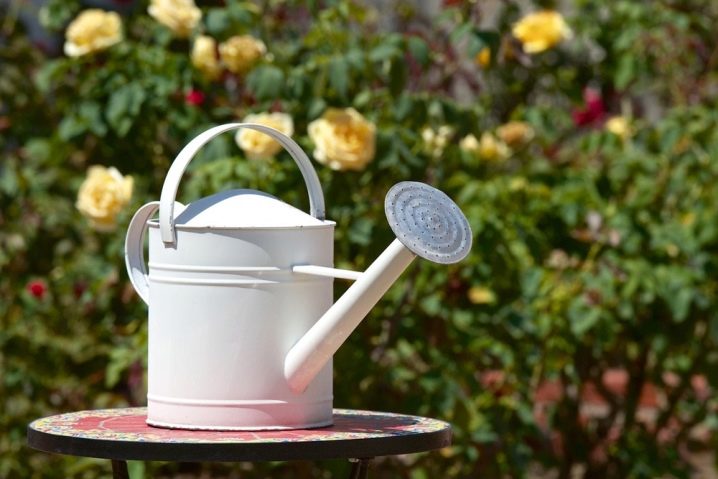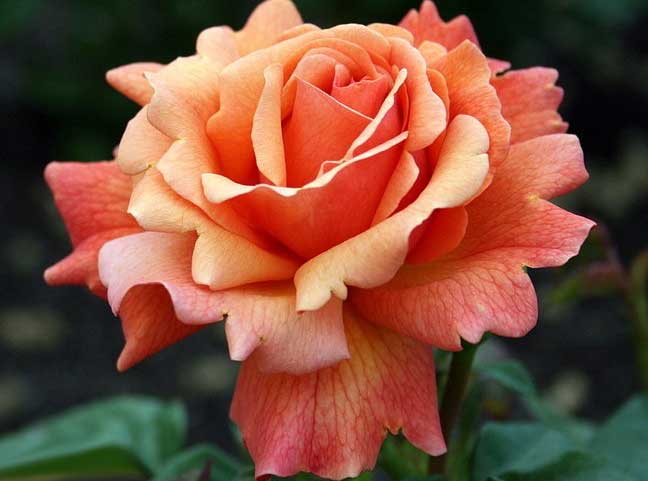Blooming rose
Since Gloria Day is a re-flowering species, the breaks between flowering periods will hardly be noticeable if you follow the rules of caring for her during flowering.
A period of activity and rest
The period of activity occurs most often in the 2nd half of June, at this time the most magnificent flowering. The duration is about 30 days, and about 40 buds have time to form on the bush. But the lifespan of each flower is short, the buds dry out after 3-4 days. The second wave begins almost immediately. If properly cared for, the buds will be just as large until the first cold weather.
Care during and after flowering
The first step is to cut the wilting buds. As soon as the flower has faded, it must be removed immediately. This will give the plant strength to form a new one. During this period, fertilizing with potassium-phosphorus fertilizers is also required.
Note! After the first wave, complex mineral fertilizers are applied
What to do if it does not bloom
The reasons for the lack of flowering always lie on the surface. It is imperative to analyze the conditions that are created for the rose. For no reason, she will not shed the buds or refuse them altogether. Shaded planting sites, overflows / underflows, improperly selected fertilizers or lack of them are all possible reasons why Gloria Day does not bloom.
Features of cultivation and agrotechnical recommendations
According to experts, the variety is quite unpretentious, forgives inexperienced gardeners many mistakes, but still requires compliance with the basic simple rules of care. The plant demonstrates high winter hardiness, under the shelter it calmly tolerates frosts down to -23 ℃, is resistant to damp weather and precipitation, is little susceptible to damage by pests, and has a high resistance to diseases and rot. In unfavorable years, it can be affected by black spot and powdery mildew.
Photophilous "Gloria" feels good in open, ventilated areas. Experienced gardeners recommend placing seedlings on the east side, where the first rays of the sun will quickly dry the dew and protect the beauty from fungus. At the same time, it is desirable that in hot midday hours it is covered with a light partial shade. In extreme heat, the flowers fade faster, while their yellow color fades, and the pink becomes brighter. The plant also feels good in low-light areas, but it is not recommended to plant it in dense shade.
 The climbing variety (claming) of the Gloria Day variety is well suited for vertical gardening in the southern regions
The climbing variety (claming) of the Gloria Day variety is well suited for vertical gardening in the southern regions
Chernozem soil fertilized with manure or peat is ideal for a plant; in this case, you can do without additional mineral fertilizing. In open ground, seedlings are recommended to be planted from mid-spring, when the ground has already warmed up enough, or at the beginning of autumn. Pruning is advised before the buds swell and before hibernation. At the end of October, the rose is huddled high, the shoots are bent down and covered with spruce branches or agrofibre for wintering.
 Planting material of the variety is offered by many nurseries and agricultural firms.
Planting material of the variety is offered by many nurseries and agricultural firms.
Shelter for the winter
This type of rose is frost-hardy, but it is better to be careful and take protective measures against severe frosts that are possible during the winter. It is not necessary to subject the plant to special pruning (about 40 cm), but after flowering, carefully cut out weak, diseased, not yet lignified shoots, leaving 5-6 strongest ones. The rose should be free of wilted and unblown flowers.

When the outside temperature drops to -5 ° C, the bush can be hidden in a shelter:
- 1Prepare a "bed" for the branches of a rose from dry leaves, grass.
- 2Prepared litter is placed in grooves that are small in size and depth.
- 3Branches are carefully removed from the support, tied into bundles and laid on the “bed”.
- 4 A covering material is placed on top of the branches, most often a plastic wrap, which is "pinned" with staples, and the edges are covered with earth. You should get a kind of tunnel, impenetrable for snow and rain, but always with air access.
There is another option, when the connected branches of a rose are wrapped in burlap, and then with a film and again tied to a support, and the root system is covered with additional layers of earth and mulch.
As the ground warms up and thaws in spring, the excess mulch is gradually removed, leaving a small layer of a few centimeters.
Description
The Indigoletta variety was developed over thirty years ago in Holland. Its distinctive features are called surprisingly original color of flowers, as well as long-term flowering: the buds do not fall off until the appearance of snow. As a rule, from 2 to 3 flowers grow on one stem, containing about three dozen petals. In the bud state, they are colored purple, and when they open, they acquire a bluish tint - lilac. The size of a blossoming flower ranges from 8 to 10 centimeters, and in shape it is somewhat reminiscent of a glass.

The height of the bush ranges from 250 to 300 centimeters, although sometimes it reaches 4 meters, and the width does not exceed 150 centimeters. The bush itself with dense rounded leaves, painted in a rich green hue, and strong stems grows powerful, strong. The rose looks very beautiful, which explains its frequent and extensive use in landscape design. The aroma of "Indigoletta" is bright and memorable. The variety is characterized by satisfactory frost resistance. If you additionally cover it for the winter, then the bush will not die even in frosts reaching -30 degrees.
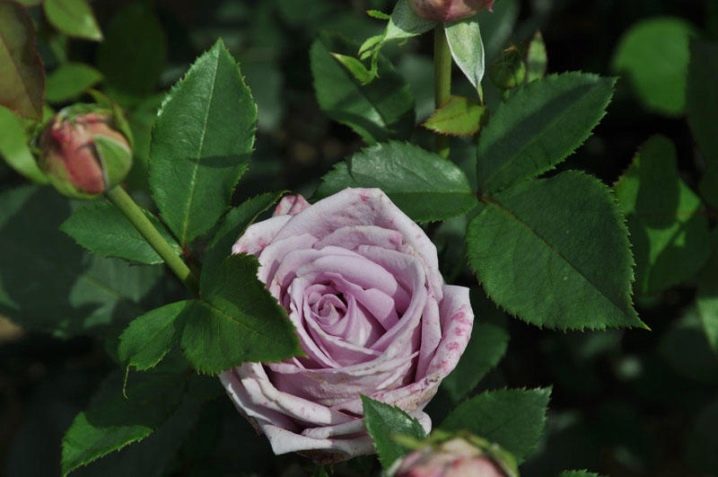
Abundant flowering occurs for the first time in late spring - early summer, and the second time at the turn of August and September. It is believed that the color of the flowers largely depends on where the bushes are planted, ranging from pale to intense shades of purple.
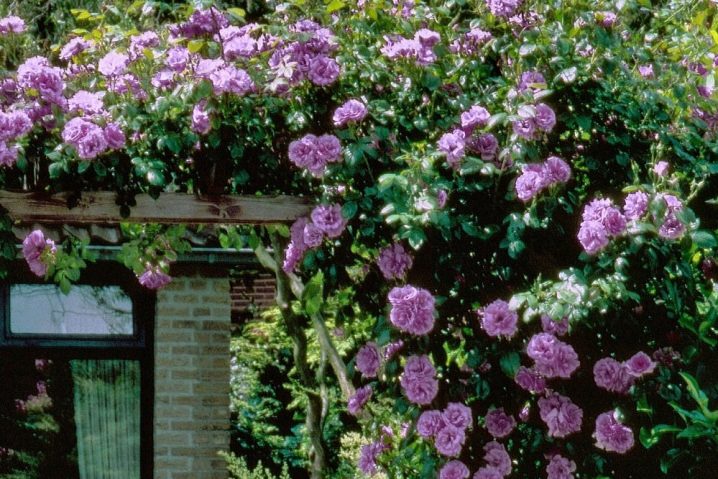
Speaking about the disadvantages of this variety, it is possible to identify the likelihood of the appearance of a fungus in a situation of high humidity. Despite the fact that the rose needs a lot of light, being in direct light, it can simply burn out and lose its beautiful petal shade. Finally, the shoots bend rather poorly, which means that some difficulties may arise when the crop is sheltered for the winter.
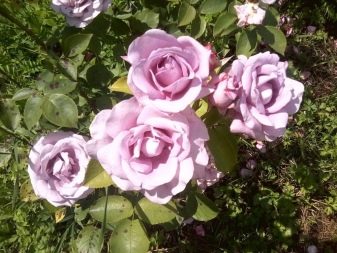

The story of the birth of Izi Daz It
The originator of the Floribunda Harkness group created a masterpiece in the UK (2010)
The Weeks Roses company in distant California gave the name to Easy Does It. And she included the extraordinary beauty rose Easy Does It in the collection of the most easy to care for and resistant to terrible black spot.
She conquered the rose communities:
- America;
- Japan;
- Australia;
- South Africa, etc.
Russia is no exception.
A rose shrub from the floribunda group, resisting the diseases inherent in its congeners, and unlike other varieties, retains an individual - a unique and extraordinary image.

The Izi Daz It rose is planted as border plantings and in rose gardens. A wonderful bright plant will decorate flower arrangements. They look original in single landings. Read about other floribundas here.
Description of the Easy Does It variety
- About the shrub - the height is more than 90 cm, the width reaches - 80 cm.
- About flowers - they are large up to 10 cm, bright, with carved velvet openwork-nostalgic petals that are not afraid of rain.
- About the color scheme - at the beginning of the dissolution of the bud - scarlet, then, as if by magic, gradually turns into orange (orange color), peach, raspberry.When the time comes to wither, the flowers, as if for the last time, saying goodbye, become sad, but in lovely light pink tones. The spectacle is stunning, a natural kaleidoscope of colors and shades.
- The aroma of the strong is delicate, pleasantly fruity.
- The foliage is glossy - shiny dark green.
- The variety is winter-hardy, but requires shelter due to its tall stems.
Growing features
The place for planting seedlings should be protected from winds, while there should be no stagnant air
Pay attention to the drainage device and the substrate. The plant requires a support for very high growth
To make the bush happy with repeated flowers, the old ones are removed.
Maintaining optimal conditions for the pet, and she, we are sure, will become such, flowering in gratitude from the plant will be tireless.
When planting seedlings, a well-lit area is chosen. The plant does not like shade and partial shade, therefore abundant flowering does not guarantee.
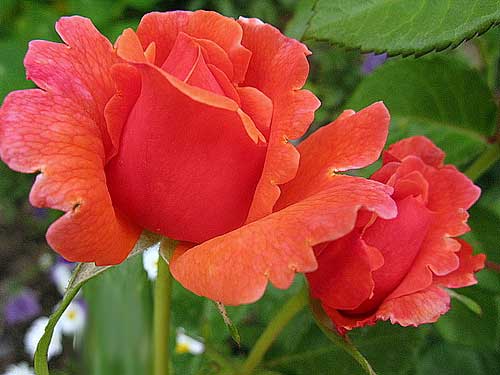
Everyone chooses their own rose and loves in their own way. Gives affectionate names, talks with rose bushes, trying to gently touch a bud or a blossoming flower, inhale a unique scent and recharge with the energy of beauty and perfection.
Rose Easy Daz It attracts from afar with its aroma and unusual noble coloring of flowers.
"I am dear Rose and I know that I am worth it." Signature: Your Rose Easy Does It.
Description of climbing rose Purple Skyliner

The Purple Skyline climbing rose, created by breeder Bred by Frank R. Cowlishaw (United Kingdom, 2002), has won the hearts of fans of royal flowers.
The rose bush seems to give us bouquets of small semi-double flowers (4.5 cm in each with 20 petals), which are collected in large tassels. Very fragrant lilac purple flowers.
The blue climbing beauty blooms all season. At the beginning of flowering, the petals of the Violet Skyner rose from reddish-lilac color smoothly to blue-violet. The sun's rays make their own adjustments to their color, changing to blue or lavender. The bush can be simultaneously colored with various purple-lilac shades.
Leaves are dull, olive, medium-sized, slightly wrinkled.
A flexible dense bush grows from half a meter to 3 m in height and up to 1 m in width. The variety looks effective on any site.
Features of the variety
The rose is resistant to rainy weather, like a bird, shakes off the refreshing droplets, and again, fresh and beautiful. Unusual colors and a unique rich aroma make it desirable in any garden.
The climbing rose variety Purple Skyliner is hardy, but still lacks warmth and sun in central Russia.
The plant is considered frost-resistant (zone 6), however, you should not risk leaving the shoots uncovered.
After planting, it is better to cut the shoots shorter, so the foreigner will take root faster. Climbing roses of this variety are planted like other representatives of this variety.
Neighborhood with other climbing roses, creating a slight partial shade, does not oppress the blue foreigner. She feels comfortable with any decorative flowers.
Agrotechnics
Growing climbing roses is exciting and even reckless when you see it in all its splendor, thanks to the labors of your righteous. But this is not an occupation for amateurs. Here, nevertheless, certain knowledge and efforts are needed.
Before moving on to useful and important information, be inspired by the beautiful song about the blue rose.
Pick-up location
Despite the fact that foggy Albion is considered the birthplace of the Purple Skyliner rose, it will not reveal its wonderful qualities on swampy soils. The soil should be loose and fertile, with moderate moisture.
The flower loves dry places and a lot of light. Feels comfortable at the southern, southwestern walls and pillars. In winter, the shoots are cut off, and the bushes are covered.
A soil mixture is prepared for a seedling for planting, which includes:
- garden land;
- sand;
- rotted manure;
- peat.
Care
When choosing a seedling, pay attention to its appearance. He must have:
- woody shoots with green bark (no more than 2-3 pcs.);
- healthy roots are well developed.
In central Russia, the most suitable time for landing:
- in autumn - September, October;
- in spring - April, May.
For a day, the seedlings are soaked in settled water. Then the shoots are shortened to 30 cm. All leaves are removed from the stems. The buds located below the grafting site are cut off so that later problems with wild growth are not created.
For planting, holes are made 50 x 50 every 2-3 m so that the bushes are not cramped. The roots should also be free. The vaccination site is not covered with soil, it rises 10-15 cm above the ground.
Seedlings are planted at a slight slope towards the support, about 30 degrees.
The bush is watered abundantly. If the soil has settled, add soil to the required level.
The trunk is earthed up in the fall and covered with suitable material, it is possible with dry foliage.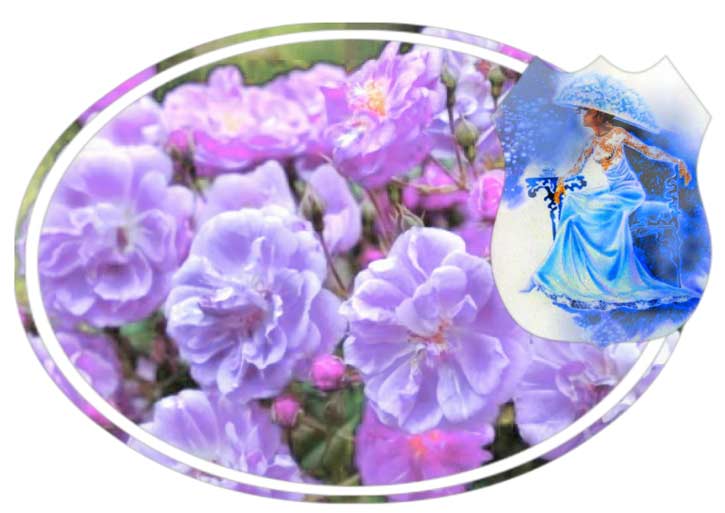
This is incredible! The English Purple Skyliner is generous with an abundance of flowers, because of which the green leaves are often not visible.
Origin of the variety
The variety has a dramatic history. It was bred by the French breeder Francis Meilland in 1935-1939 in a family nursery through complex interspecific hybridization and was named after the author's mother. In 1942, before the occupation of France by German troops, Meilland, in an effort to save the results of his long painstaking work, secretly sent several cuttings to friends and colleagues in the USA, Germany and Italy. Moreover, the future beauty went to America on the last plane, under the guise of a diplomatic mail.
 When creating, the seedlings obtained from the crossing of Georqe Dickson (pictured left) x Souv were used. De Claudius Pernet and Johanna Hill (pictured right) x Charles Kilham pollinated with pollen from Marqaret McGredy
When creating, the seedlings obtained from the crossing of Georqe Dickson (pictured left) x Souv were used. De Claudius Pernet and Johanna Hill (pictured right) x Charles Kilham pollinated with pollen from Marqaret McGredy
Gloria Day returned home only after the end of the war. In 1945, she made a splash and set new quality standards by receiving the All-American Bureau of Rose Selection Award. For outstanding merit, the variety was awarded gold medals by the American and British Royal Rose Societies. In 1965 in The Hague he received the title of "Golden Rose", and in 1976 - was inducted into the Hall of Fame of the World Federation of Rose Society. In 2000 he was awarded the title "Rose of the 20th Century".
Description of hybrid tea rose Gloria Day
This variety with beautiful large flowers is considered the most famous rose of the last century.
Appearance, height and size of the flower
The bush is powerful, grows up to 1.5–2 m, straight, branched. Its width reaches 1 m. One bud usually grows on one shoot, but sometimes more. The stems are covered with large thorns. The dark green leaves are dense and glossy.
The flowers of the Gloria Day rose are very large (14–19 cm), the unblown buds have the shape of a glass, after they have fully bloomed, the roses look like peonies - double, with a large number of petals. Closer to the middle, the petals are pale yellow, and at the edges are pink or crimson. If the rose grows in bright sun, the petals become creamy with a bright pink tint, and in partial shade they are darker. Depending on the growing conditions, the rose can have a strong aroma or be odorless at all.
The rose becomes fully decorative in the third year after planting. Gloria Day does not freeze in temperatures down to –23 ° C. It is mainly cultivated in the southern regions of Russia and Ukraine, as it belongs to 5-11 zones of frost resistance (from +7 to -23 ° C), but under the shelter the bushes tolerate well the winters of central Russia (Moscow region) and related to the warm humid the climate of the regions of the North-West (part of the Leningrad region, Kaliningrad).
The variety grows successfully in damp summers, does not stop flowering with frequent rains. When the weather is rainy and warm, the buds and flowers look beautiful and healthy despite the humidity. And if the rains are accompanied by a cold snap, roses can get sick with gray rot. The plant tolerates heat well.
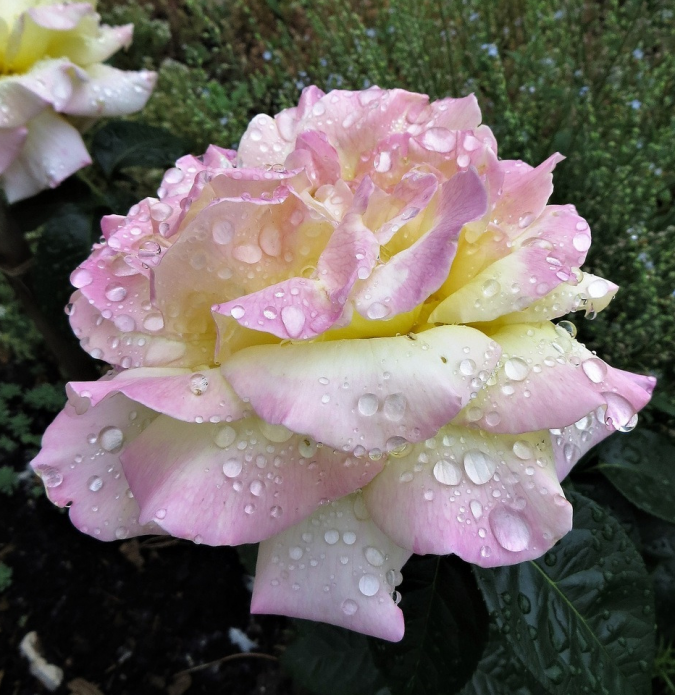
Even on a rainy summer rose Gloria Day does not stop flowering
Video: description of the rose Gloria Day
History of creation
The variety was bred even before World War II, in the second half of the 30s of the XX century, by a breeder from France Francis Meyan. He named the flower Madame A. Meilland after his mother, who died at a young age.
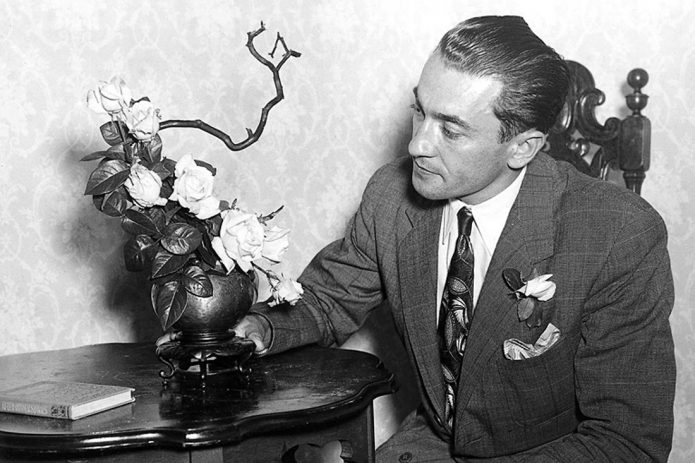
Francis Mayan - breeder who bred the Gloria Day rose variety
However, due to its popularity, the rose received different names in different countries:
- Italians call her Gioia;
- the Germans call Gloria Dei;
- to the Americans and the British, the flower is known as Peace;
- in Russia, where the rose came from Germany, it is also known as Gloria Day.
Varieties of varieties
Due to its popularity, Gloria Day was often used for breeding new varieties:
-
Russian Scarlet Sails, Vasilisa the Beautiful, the Beauty of the Festival and others;
- foreign Chicago Peace, Princess de Monaco, Dame de Couer and others;
- climbing rose Peace CI.
Flowering features
By the type of flowering, this variety is referred to as re-flowering. It delights gardeners throughout the summer from early July to early autumn. Moreover, two waves of flowering are noted: July and August. In the middle of summer, the bush can give about four dozen buds, and by the end of the season, the number of flowers decreases. In the southern regions, Gloria Day blooms until cold weather. In order for the bush to show itself in all its splendor, it is necessary to pick off the faded buds in time.
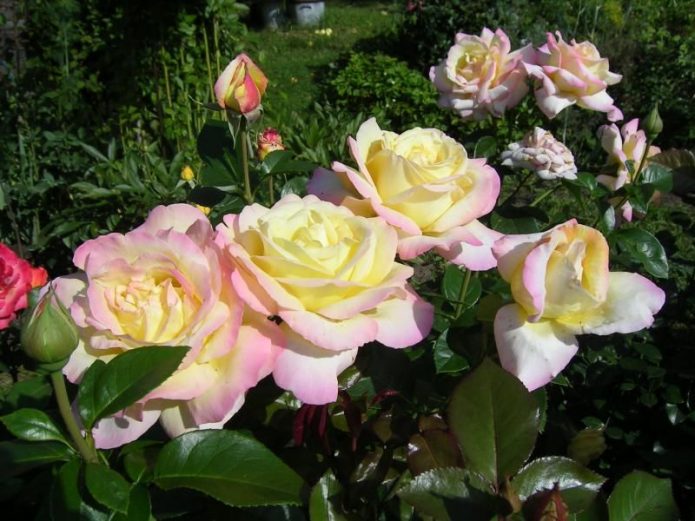
Rose Gloria Day blooms from the beginning of July for two months and sometimes longer
The use of roses in cutting and landscaping
Roses with a strong aroma are good for cutting; when you add aspirin to the water (half a tablet per vase) or one and a half teaspoons of sugar with a teaspoon of citric acid, they will stand in the vase for a long time - up to a week. In the garden, they are planted in flower beds - narrow flower beds along paths or fences with different plants, on flower beds in front of the house. Due to the height and width of the bush, the rose will look good in single plantings (as an accent on the lawn, for example). Sometimes Gloria Day is grown as a trunk. The bushes are widely used for commercial planting.
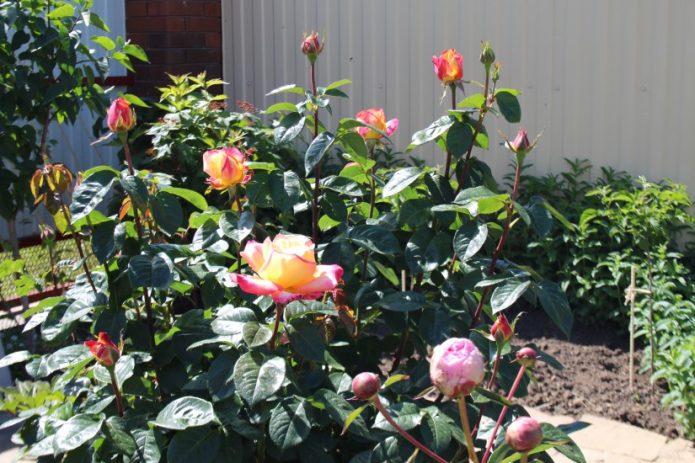
Thanks to the lush tall bush, Gloria Day roses look good in single plantings.
Growing a flower
Planting this variety of roses in open ground is similar to planting many other hybrid tea varieties.
Climbing rose Gloria Day is planted in open ground in one way - with seedlings, which can be freely purchased at the horticultural market, nursery or flower shop.
Note! In Central Russia, planting is carried out in the second half or end of May, when the air and soil warm up enough, and the risk of frost has passed.
Seat selection
The flower is planted in a sunny place, which is protected from drafts and gusty winds. It is good if any green manure plants were grown in front of the rose in this place. For this variety of roses, legumes or asters are those.
How to prepare the soil and flower for planting
Soil preparation begins in the fall. At this time, the land where the rose will be grown is well dug up, mineral and organic fertilizers are applied (cow dung is most often preferred from organic matter). Then add the garden fertile soil. That's all, the soil mixture for spring planting is ready.
Plants are prepared just before planting: cut the shoots, leaving 2-3 of the strongest ones, the length of which should be about 13 cm. The root system is cut by 30 cm.
Landing procedure
Step-by-step instruction:
- In the spring, when the soil settles, holes 30x30 cm are dug in it.The distance between the flowers should be at least 30 cm, between the rows - at least 50 cm.
- The roots of the flower are carefully straightened and the hole is covered with soil.
- The substrate is well tamped and watered.
- A young seedling is sprinkled with peat 15 cm.
Important! An autumn planting of a plant is also possible, but you need to guess such a time so that the flower has time to take root before the onset of cold weather, and for the winter such a rose will have to be covered especially carefully
Flower propagation
Since Gloria Gray is a hybrid, it will not work to propagate it by seeds, otherwise the main characteristics of the mother plant will not be preserved. Therefore, the surest way is grafting.
Important! The spring version of cuttings is preferred, but it can also be carried out in early autumn. Cuttings are cut from the stems of the second year of life (not earlier)
They should have 3 buds and 3-4 leaves. The thorns are removed completely, the bottom sheet is removed, the top one is cut off by 1/3. During the day, the cutting is kept in a solution of a root growth stimulant, after which they are planted in open ground and covered with plastic bottles, which are periodically raised for ventilation. After rooting has taken place, the shelter is removed
Cuttings are cut from the stems of the second year of life (not earlier). They should have 3 buds and 3-4 leaves each. The thorns are removed completely, the bottom sheet is removed, the top one is cut off by 1/3. During the day, the cutting is kept in a solution of a root growth stimulator, after which they are planted in open ground and covered with plastic bottles, which are periodically raised for ventilation. After rooting has taken place, the cover is removed.
Video
In conclusion, we suggest watching several videos in which experienced gardeners share their views on the peculiarities of growing "Gloria". You may also be interested in the advice of a specialist on planting and caring for pink seedlings:
Found a bug? Select the text with the mouse and click:
Ctrl
+
Enter
Do you know that:
Natural toxins are found in many plants; those that are grown in gardens and orchards are no exception. So, in the seeds of apples, apricots, peaches there is hydrocyanic (hydrocyanic) acid, and in the tops and peel of unripe nightshades (potatoes, eggplants, tomatoes) - solanine. But do not be afraid: their number is too small.
Care
High-quality flowering of the variety will be ensured by regular pruning, carried out according to the rules. Strong first-order shoots should not be touched, but second-order shoots should be pruned, leaving only those that show maximum efficiency. In addition, dead stalks should always be removed.


In the spring, the Indigoletta rose needs to be fertilized with phosphorus, potassium and nitrogen. In the summer months, when the first stage of flowering ends, the bush should be fed with a complex of potassium and phosphorus, which already contains a minimum amount of nitrogen. In August, nitrogen should disappear altogether from the diet, and fertilization should be done more with potassium. In addition, even before the beginning of the appearance of flowers, it is worth spraying the bushes with boric micronutrient fertilizers.


If the winter in the region is usually mild, then it will be enough to spud and qualitatively mulch the lower part of the bush. When shelter is still necessary, you will first have to bend the tough whips, and this will have to be done in several stages. First of all, they are girded with rope loops, then they are slightly tilted to the ground and fixed with pegs. Seven days later, the rope will have to be shortened in order for the rose to bend more.

This procedure should be repeated several times before the "Indigoletta" comes to the desired position. To prevent the lash from breaking during this procedure, experts recommend placing round pieces of wood under the base. In the final stage, the bush is protected by an air-dry shelter. For example, it can be a polyethylene film, fixed with staples and earthen piles. Ideally, a kind of tunnel should form, in which there is air, but there is no access for atmospheric precipitation.

An important part of crop care is the prevention of common diseases. Already from March, the bush should be sprayed with fungicides, for example, Bordeaux liquid or stronger preparations
This should be done only in dry weather without wind.In addition, in the spring it is recommended to treat the bushes with copper sulfate, and in the summer with a mixture of soap and soda ash. This procedure will prevent the appearance of powdery mildew.
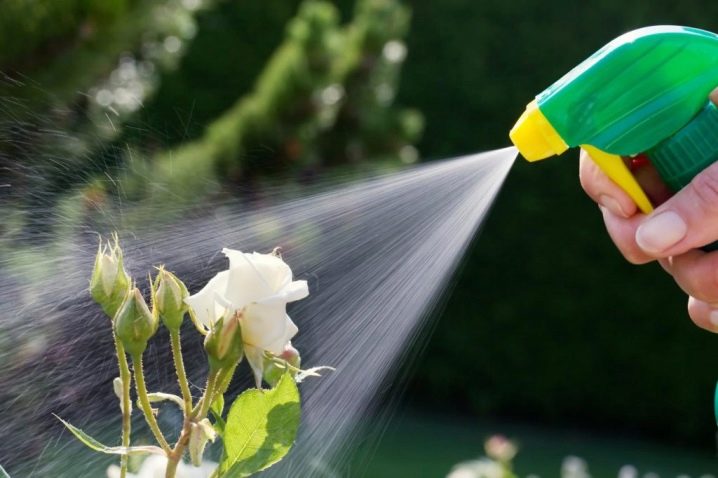
After winter, it is important to destroy all stems, leaves and branches that are either frozen, or infected, or broken, or were affected by putrefactive diseases. If this is not done, the remaining debris can be a source of disease or insect pests.
It is important to mention that if the rose does not bloom well, then it is recommended to change the position of its lashes. If you make them more horizontal, after fixing them on a special support, it will turn out to activate the development of the buds and, accordingly, the appearance of flowers.
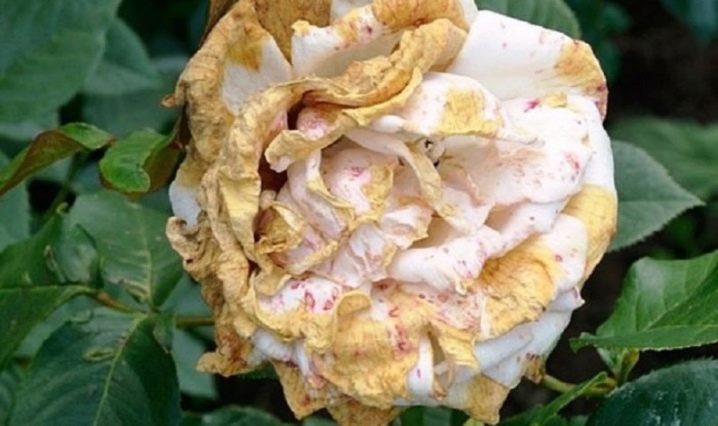
Watering this variety is necessary quite often. Immediately after planting, irrigation is carried out once daily in the absence of rain. Following watering is carried out as needed, sufficient, but not excessive, since excess moisture immediately leads to decay of the root system. If necessary, you can create a special drainage system. Each irrigation, both natural and artificial, ends with a loosening procedure. This procedure prevents stagnation of fluid and activates the flow of air to the root system. Also, to protect the soil, it can be mulched, for example, with straw. This will maintain the looseness and the required amount of moisture in the soil.
